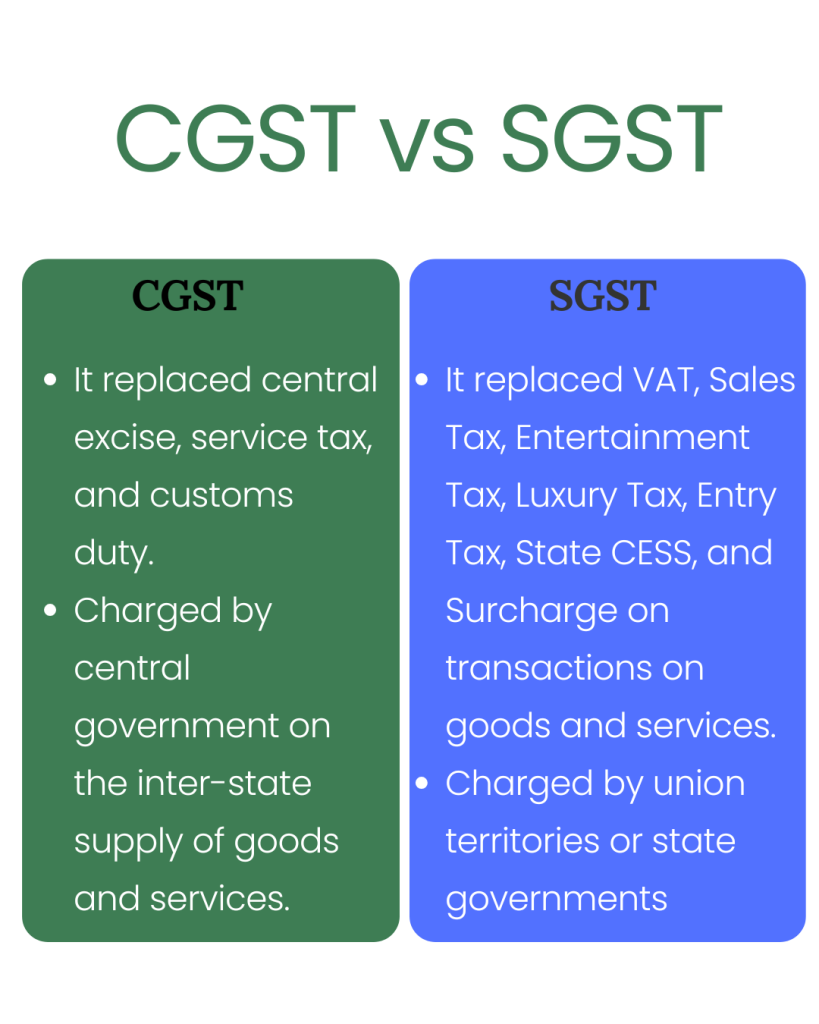How CGST is Different From SGST?
The Goods and Services Tax was introduced by the central government to eliminate the old tax regime in the country. Under the previous tax regime, Central Excise, Service Tax, State VAT etc. were part of the taxation. It had a cascading effect on the taxpayer as the taxpayer was taxed on multiple levels. Therefore, the government introduced GST (goods and services tax) to simplify the tax regime in India. This article discusses CGST vs SGST and major differences between these two indirect taxes.
Under the current taxation system GST, there are several components. Now the type of transactions decide who will charge the tax. The following are the components of GST
- CGST: Central Goods and Services Tax
- SGST: State Goods and Services Tax
- UTGST: Union Territory Goods and Services Tax
- IGST: Integrated Goods and Services Tax

What is CGST under GST?
The central government charges CGST on the intra-state supply of goods and services. The CGST replaced previous tax regimes lime central excise, service tax, and customs duty. The CGST is collected when the transactions have taken place in a single state or they are intra-state transactions.
Both central and state governments have agreed to charge CGST and SGST at the same rate of tax from the end consumers. It is evident in section 8 of the CGST Act, that the maximum rate of CGST and SGST cannot be higher than 14% each and both the taxes are charged at the same rate.
If a buyer sells a product in Gujarat to a buyer from the same state or union territory, CGST and SGST will apply to this transaction. Both the state and the central government will charge the tax at the same rate from the consumer.
What is SGST under GST?
SGST is similar to CGST the only difference between these two is that the central government charges CGST while the state government and union territories charge SGST or UTGST respectively. SGST is applied when intra-state transactions take place. SGST replaced the previous state taxes including VAT, Sales Tax, Entertainment Tax, Luxury Tax, Entry Tax, State CESS, and Surcharge on transactions on goods and services.
For example, if a product is sold in the state where it is being consumed, suppose the rate of GST is 18% on that particular product. In such a case, both the state and central government will keep 9% each.
The only major difference between CGST and SGST is that the former is charged by the central government whereas the latter is charged by the state governments.
CGST vs SGST
Integrated Goods and Services Tax is charged when the taxable goods and services are supplied interstate. When the business is taking place between two or more states or union territories, then IGST is charged by the government.
Even in the case of import to India and export from India, IGST applies to the supply of goods and services. The tax amount will be shared by both central and state governments.
Get Started with TaxDunia
Get yourself registered under the GST to reap several benefits provided by state and central government. The GST Registration gives your business the due recognition it deserves and boost the funding. Get started with TaxDunia today to know more about the GST Registration and how to thrive in new tax regime in the country.

